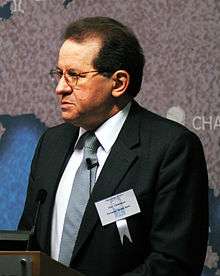Vítor Constâncio
| Vítor Constâncio | |
|---|---|
 Constâncio at Chatham House in 2013 | |
| Vice President of the European Central Bank | |
|
Assumed office 1 June 2010 | |
| President |
Jean-Claude Trichet Mario Draghi |
| Preceded by | Lucas Papademos |
| Governor of the Bank of Portugal | |
|
In office February 2000 – 31 May 2010 | |
| Preceded by | António de Sousa |
| Succeeded by | Carlos Costa |
| Personal details | |
| Born |
12 October 1943 Lisbon, Portugal |
| Political party | Socialist Party |
Vítor Manuel Ribeiro Constâncio, GCC, GCIH (born 12 October 1943) is a Portuguese economist and politician, Vice President of the European Central Bank. Constâncio graduated in economics from the Universidade Técnica de Lisboa.
Career
Constâncio was secretary-general of the Socialist Party from 1986 to 1989. He lost the legislative elections of 19 July 1987, but remained in office. He resigned the following year, being replaced by Jorge Sampaio.
Constâncio was governor of the Banco de Portugal, the Portuguese central bank, for the first time in 1985-86, having been appointed vice-governor in 1977, in 1979, and in the period from 1981 to 1984.[1]
From 1993 to 1994, Constâncio served as chairman of Lisboa 94, the entity in charge of organizing the commemorative events of Lisbon as European Capital of Culture.
Between 1995 and 1999, Constâncio was a member of the Portuguese Council of State. During the same period, he served as Member of the Board (Executive Director) of Banco Português de Investimento (BPI), a leading private Portuguese banking group, with responsibility for Budget, Accounting and Control of Financial Market Risks. In this capacity, he represented BPI as non-executive member of the board of Portugal Telecom and subsequently as non-executive member of the Board of Energias de Portugal.
Constâncio served once more as governor of the Banco de Portugal from 2000 to 2010, having been re-appointed in 2006.[1] Under his presidency the Bank of Portugal spent one third of its original holdings of 600 tons of gold to 400 tons, approximately.[2]
While in office, he advocated salaries stagnation or increases below inflation, as a way to increase the Portuguese economy's competitiveness. In 2005, Constâncio enraged right-wing politicians when he reviewed the previous conservative government's figures and revised the deficit up from around 3% to 6.8%.[3] Two Portuguese banks (Banco Português de Negócios (BPN) and Banco Privado Português (BPP) had been accumulating losses for years due to bad investments, embezzlement and accounting fraud. The Portuguese Central Bank, led by Constâncio, was criticized for having allowed this situation for years.
European Central Bank, 2010–present
Constâncio was first mentioned as a potential vice president of the European Central Bank in 2002, to replace Christian Noyer. He cited family reasons for refusing to run for the post.[3]
Constâncio was appointed vice president of European Central Bank, for an eight-year mandate.[4] At the time, he was chosen by Eurozone finance ministers ahead of Peter Praet, director of the National Bank of Belgium, and Yves Mersch, the governor of the Bank of Luxembourg, to replace Lucas Papademos of Greece.[5]
Shortly after, on 6 April 2011, the Portuguese Government, facing increasing difficulties in securing its financing needs in the international financial markets, formally requested international financial assistance leading to a €78 billion program with equal participation of the European Financial Stabilisation Mechanism, European Financial Stability Facility and International Monetary Fund.
Other activities
- Banco de Portugal, Member of the Advisory Board[6]
References
- 1 2 "Vítor Manuel Ribeiro Constâncio". Bank of Portugal. Retrieved 7 February 2010.
- ↑ Portugal: as más vendas de ouro. informacaoincorrecta.blogspot.pt, retrieved 25 May 2015
- 1 2 Luís Rego (February 24, 2010), Political banker European Voice.
- ↑ "2010" (PDF). Diário Económico. Archived from the original (PDF) on 4 July 2011. Retrieved 31 December 2010.
- ↑ Jim Brunsden (February 15, 2010), Portugal wins vice-presidency of ECB European Voice.
- ↑ Advisory Board Banco de Portugal.